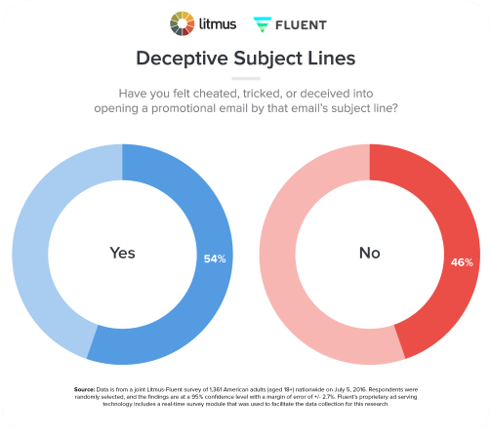Subject lines can be tricky, which may or may not be one of the reasons why you are here reading this post. Your subject line should ideally help your email stand out from others in your recipient’s inbox. Your subject line needs to capture attention and encourage action from recipients. In a perfect world, people would see your subject line and immediately want to click your email to see what else is inside. That is the goal, at least to most email marketers. In order to achieve this goal, you have to know what works and what doesn’t. However, it is not as cut and dry as that. The ‘do’s’ and ‘don’ts’ of subject line creation are not necessarily the same across the board. This is why testing your subject lines is another important aspect of perfecting the art of writing subject lines.
Subject Lines that Work
Make it Personal
Personalizing your subject lines is a great ‘low hanging fruit’ tactic that is simple and effective. Some ideas for how to personalize your subject line include: using your customers name, previous purchase details, geographic location, and so many more! Generally, subject lines with personalization can increase open rates by as much as 25%.
Who is getting personal in my inbox? Check out this personalized (and incentivized) subject line from Kohls:

There’s some evidence that having a person as your from name rather than your company can increase open rates by as much as 35%, but you’ll want to test this by comparing opens with clickthroughs—are people just opening because they are unfamiliar with the sender name and then moving on without interacting with the email’s content? Transparency is super important for building trust with your recipients, so if testing yields results that suggest your subject lines are deceptive rather than transparent, you’ll want to shift your strategy toward rebuilding trust (with transparency) for your list.
Be Descriptive
The key is to make it very clear what the email contains and leave no doubt what readers will find inside when they open it, according to Agile CRM. When writing your subject lines, it might be helpful to consider the following questions:
- What is your email about?
- What are you offering?
- Are you notifying recipients about a new product launch, an event, a special offer?
Who is getting descriptive in my inbox? I can clearly see from the subject line that it looks like Sephora has some important new information that they want to share with me:

Or check out the intrigue created with this subject line, where they ask a question the email content will answer:

Avoid Being Labeled as Spam
One of the best ways to ensure you are creating effective subject lines is to ensure you are not creating spammy subject lines. Nearly one in five emails gets caught by a spam filter and is sent to the spam folder. Spam trigger words are keywords or phrases that email providers see as red flags. These are often words that you will find in emails that people mark as spam. Need a quick list of the top spam words to avoid? Check out this list of 188 words and phrases you should not use in your subject lines.
Don’t Be Tricky
As tempting as it sounds to see a lift in open rates, tricky subject lines destroy your trust with your audience. This means no fake FWD or RE or references to transactions or meetings that never actually happened.

What Doesn’t Work with Subject Lines
Be Careful with Emojis
We know that emojis are super fun. But they can – at times – be seen as unprofessional, distracting, and potentially spammy. This is why it is so important to know your target audience and how they may perceive emojis being used in your subject lines. Studies, like this one from Return Path, have shown that while using emojis may result in an increased open rate, chances are that it might also lead to an increased complaint rate.
After peeking in my spam folder, 3 out of the 4 emails in there included emojis in the subject lines:

Excluding Pre-Header Text
As a rule of thumb, you should always have meaningful pre-header text that will display alongside your subject line. This is a part of emails and subject line creation that is overlooked far too often. According to Stirista, “the pre-header space is vital. In many email providers, the first line of the email shows up as a preview in the inbox screen. In other words, it’s an extra chance to gain a click-thru.”
This email from Jonathan Adler did a great job using the pre-header text to add new information and additional value to their email, even before I opened it:

It’s important to think how these work together—you want to avoid a situation where your subject line might be “Don’t Forget” and your preheader is “to unsubscribe, click here”!
Avoid Using Click-Bait
Your subject line needs to deliver on its promise about the email that follows. Do not try to “bait” readers with inaccurate information or false promises. In accordance with the CAN-SPAM Act, your subject line should reflect the content of the email. In fact, according to Return Path, click-bait headlines are clicked less than average open rates.
What You Should Consider Testing
Subject Line Length
There have been conflicting results from studies completed that are looking at which subject line length performs the best. Some studies say longer subject lines can increase your open rate, while other studies suggest that is not the case. The easiest way to resolve this unknown for you? Run an A/B test! There’s no concrete answer about what length is always the best. Try out subject lines that are significantly different lengths but try to keep the message as similar as possible.
Capitalization vs. No Capitalization
Having some words or phrases in your subject line can sometimes come off as spammy, but it can also help an email stand out from others in an inbox. In one study, MailChimp found that having the entire subject line capitalized produced a small, but significant increase in open rate. This may be something worth testing out for your emails!
Urgency vs. Non-Urgency
In a 2012 study about mobile email trends, Chief Marketer found that email subject lines with a sense of urgency had 22% higher open rates. That is an impressive statistic if it is accurate – definitely worth testing out on your own emails. So, how do you create a sense of urgency? One way is to try and include the word tomorrow in your subject lines. There has been research to support that subject lines that include the word “tomorrow” boosted open rates by 10%.
Bath & Body Works is one company that uses this tactic in their messaging:

As we come to the end of this post, I hope everyone is walking away with just a little bit more confidence in their subject line strategy. By keeping some of these do’s and don’ts in mind, you should have a better idea for how you can improve your current subject line performance. But remember, that this is not a ‘one size fits all’ kind of thing, so some subject lines may work for some audiences and not for others. That is why you should always be testing new tactics and narrowing in on exactly what works for your brand and customers.

